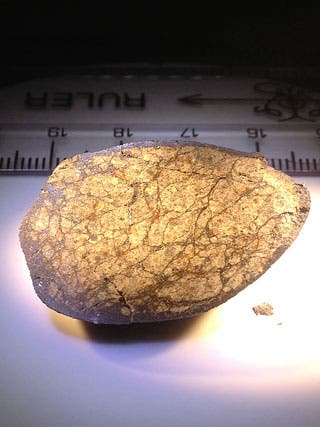At the beginning of the year the most powerful meteoroid strike since the infamous Tunguska event took place in Russia, over Chelyabinsk. The meteor exploded many kilometers above ground, however the event released so much energy that it appeared much brighter than the sun and the ensuing shock wave caused billions of rubles worth of damage and sent over 1,200 people to hospitals in the Chelyabinsk Oblast area that day. Was this bad luck or were we actually fortunate nothing more damaging occurred? Well, it’s best if we consider this a wake-up call.
“If humanity does not want to go the way of the dinosaurs, we need to study an event like this in detail,” said Qing-zhu Yin, professor in the Department of Earth and Planetary Sciences at UC Davis.
Now, many months after the event an international team of scientists report their final findings. Apparently, the Chelyabinsk meteorite was made out of “ordinary chondrite”, or the most common material such cosmic bodies are made of. It entered Earth’s atmosphere at a whooping velocity of 19 kilometers per second and eventually the 20-meter sized alien rock eventually exploded at 30 km altitude from the high stress energies it was subjected.
The explosion was equivalent to about 600 thousand tons of TNT, 150 times bigger than the 2012 Sutter’s Mill meteorite in California. Its brightness peaked at an altitude of 29.7 km (18.5 miles) and was so intense that it appeared brighter than the sun. In fact, there had been reports of people hospitalized for severe sunburns. As for the shock wave itself that actually caused 99% of the damage it traveled 90 kilometers (50 miles) on either side of the trajectory.
Meteor impact – a reality

At the moment of explosion, some three quarters of the meteoroid (a meteoroid is the rock still in space or air; a meteorite is the rock that impacts the ground) evaporated instantly. The rest (4,000 to 6,000 kilograms, or less than 0.05 percent of the original mass)were fragmented into tiny pieces and dispersed over a wide area – the biggest chunk weighed about 650 kilograms and was recovered from the bed of Lake Chebarkul.
Most of these facts so far have already been determined shortly following the meteoroid event, greatly thanks to a lot of footage citizen science provided. This analysis only serves to paint a more detailed picture. The study does however provide some valuable new insights. Following isotopic analysis, magnetic properties determination and X-ray computed tomography scanning of the meteorites, the researchers learned a great deal about the history of the rock.
According to their findings, the Chelyabinsk meteoroid was 4,452 million years old and most likely originated from the Flora asteroid family in the asteroid belt, but the chunk that hit the Chelyabinsk area was apparently not broken up in the asteroid belt itself. Interestingly enough, the rock wasn’t at its first collision event. Previously, the researchers estimate, the meteoroid went through a significant shock event about 115 million years after the formation of the solar system 4,567 million years ago.
“Chelyabinsk serves as unique calibration point for high energy meteorite impact events for our future studies,” he said. Technology for early detection of these objects is needed, Yin said — such as the Large Synoptic Survey Telescope, currently being developed by an international team headed by UC Davis physics professor J. Anthony Tyson.
The team was led by Olga Popova of the Russian Academy of Sciences in Moscow, and by NASA Ames and SETI Institute meteor astronomer Peter Jenniskens, and included 57 other researchers from nine countries. The findings were reported in the journal Science.






